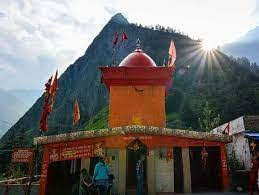A pilgrim refuge, especially in the Himalayas.
The term chatti is a derivative of the word "umbrella," and it was coined because these shelters were often only roofs supported by pillars, keeping pilgrims dry in the event of rain.
Many Himalayan pilgrims journeyed on foot until the middle of the twentieth century, using a network of chattis along the pilgrimage routes.
These chattis were eight to twelve miles apart, making for a pleasant day's walk for youthful pilgrims but a difficult trek for the elderly.
Each chatti was run by a local family that sold wood and food grains to the pilgrims and provided them with cooking equipment.
During the pilgrimage season, this arrangement provided money to mountain families while also allowing pilgrims to carry just their personal items.
The introduction of paved roads and bus transit made this network mostly obsolete, but it is still referenced in place names like Janaki Chatti and Hanuman Chatti.
Nagas from Chatuh-Sampradayi.
Four groups (sampraday) of militant (Naga) ascetics who are all followers (bhakta) of the deity Vishnu are referred to as the Vishnu Sampraday.
They are all spiritual descendants of a distinct Vaishnava religious group, each of which is linked to a prominent Vaishnava person.
The Shri sampraday of the Ramanandi ascetics is by far the most numerous and influential of these organizations, tracing its lineage back to the poet-saint Ramananda and the southern Indian philosopher Ramanuja, whom they believe to be Ramananda's teacher.
The Nimbarki ascetics' Sanaka sampraday may trace their spiritual heritage back to the philosopher Nimbarka.
The Vishnuswami ascetics' Rudra sampraday may be traced back to an older person, Vishnuswami, via the scholar Vallabhacharya.
Finally, the Gaudiya Vaishnava ascetics' Brahma sampraday traces its spiritual lineage from Bengali saint Chaitanya to southern Indian scholar Madhva.
Each of these sampradays is distinguished not only by its founder, but also by the god or deities that serve as its patron.
The Ramanandis worship the deity Rama, while the rest revere the god Krishna and his wife, Radha, to varying degrees.
Scholars dispute that these organizations were ever linked to the individuals who claim to be its founders.
The differences between the sampradays seem to be mostly intellectual in nature.
Given that Ramanandis make up the vast bulk of these ascetics, the others seem to be significant mainly as representatives of other prominent Vaishnava religious leaders.
The group differences are only important during the Kumbha Mela bathing (snana) event, when they dictate the order of specific groups in the bathing processions.
More information may be found in Peter van der Veer's 1988 book, Gods on Earth.
Discover more about Hindu Art, Architecture, and Iconography here.
You may also want to read more about Hinduism here.
Be sure to check out my writings on religion here.



